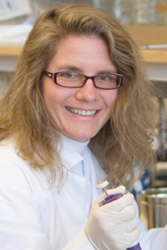Laura Knoll
Home Department: Medical Microbiology & Immunology
Location: 3303 Microbial Sciences Building
Education: BA, Saint Olaf College, Northfield, MN
PhD, Washington University School of Medicine, St. Louis, MO
Postdoctoral Research- Stanford University, Stanford, CA
Lab website: https://knolllab.mmi.wisc.edu/
Studying the host/pathogen interactions of protozoan parasites, including Toxoplasma gondii, the causative agent of toxoplasmosis, and T. gondii‘s diarrhea-causing cousins Cryptosporidium parvum and Entamoeba histolytica.



